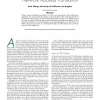Free Online Productivity Tools
i2Speak
i2Symbol
i2OCR
iTex2Img
iWeb2Print
iWeb2Shot
i2Type
iPdf2Split
iPdf2Merge
i2Bopomofo
i2Arabic
i2Style
i2Image
i2PDF
iLatex2Rtf
Sci2ools
NETWORK
2008
2008
A retrospective view of network address translation
Today, network address translators, or NATs, are everywhere. Their ubiquitous adoption was not promoted by design or planning but by the continued growth of the Internet, which places an ever-increasing demand not only on IP address space but also on other functional requirements that network address translation is perceived to facilitate. This article presents a personal perspective on the history of NATs, their pros and cons in a retrospective light, and the lessons we can learn from the NAT experience. A Retrospective View of Network Address Translation Authorized licensed use limited to: IEEE Xplore. Downloaded on February 9, 2009 at 17:52 from IEEE Xplore. Restrictions apply.
| Added | 14 Dec 2010 |
| Updated | 14 Dec 2010 |
| Type | Journal |
| Year | 2008 |
| Where | NETWORK |
| Authors | Lixia Zhang |
Comments (0)

